arriving in Berlin for instance by train
at the Central Station
here entrance Washington place
The conference took place at the
Deutsches Historisches Museum,
Unter den Linden 2, 10117 Berlin


| ANNE WANNER'S Textiles in History / cieta conference in Lyon, France - 2013 |
|
arriving in Berlin for instance by train at the Central Station here entrance Washington place The conference took place at the Deutsches Historisches Museum, Unter den Linden 2, 10117 Berlin |
 |
 |
 |
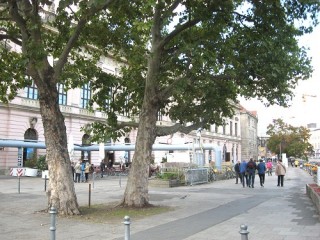 |
 |
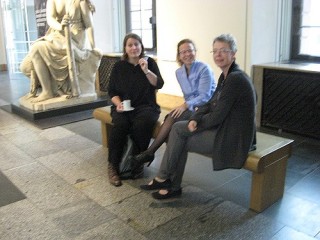 |
 |
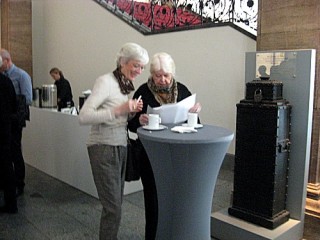 |
BERLIN, GERMANY |
| For centuries,
textiles have been transported over long distances, be it
as costly commodities or diplomatic gifts, as spoils of
war or part of a bridal trousseau. Their arrival in a new
place occasionally coincided with changes in form and
function. Even textiles that remained in a given place
were often adapted to new fashions and uses. Textiles
also served as vehicles, transporting ornamental motifs
and patterns, dress styles or constructions from one
place or even one culture to another one. All aspects of transfer and exchange, adaptation or variation will be considered in papers presented during the congress. Here are following some summaries of lectures concerning embroidered textiles: |
| Medieval Textiles, between East and West |
| Dr. Masako Yoshida, Japan, Kyoto City University of Arts |
| The Transformation
of "Pelican in her Piety" - from Europe to
India, China, Japan and the Andes Summary In the Great Navigation Period, textiles designed with the European icon "Pelican in Her Piety" were traded to various countries. As a result, this motif was accepted and transformed into eclectic images in non-European countries such as China, India, and the Andes. In this presentation, I will introduce several textiles with this icon, which were produced in China, and traded to Japan in the 16th to 17th centuries. Taking the Portuguese and Spanish trade into account, textiles with "Pelican in Her Piety," produced in Europe, China, India, and the Andes will be compared. I will also discuss Japanese consumption of these items. Dynamic expansion of this motif, disappearance of its religious implication, the alteration in forms for usage, and new functions in exported countries will be clarified through this discussion. |
| PD Dr. Evelin Wetter, Switzerland, Abegg-Stiftung, Riggisberg |
| Made in the East,
but in a Western Tradition: Transsylvanian Embroideries
around 1500 Summary Current research on the textile treasures in the Black Church in Brasov as well as of other Lutheran parish churches in southern Transylvania reveals some specific groups of .embroideris for liturgical vestments. Due to their 'hidden' existence these textiles are largely unknown to art historians focusing rather on western European art instead of on artifacts in the East. However, the specific iconography and several motifs of these embroideries reflect close contacts between their makers and the western tradition: On the one hand the embroiderers used all kinds of instruments of a late medieval artistic transfer, especially prints, but also drawings in order to trace whole compositions. On the other hand they did not just copy these western elements, but incorporated these into their own pictorial tradition as well as into their workshops' practice of embroidery. Therefore Transylvanian embroideries can be described as high quality results of a late medieval cultural transfer. |
| Early Modern and Modern Textiles, between East and West |
| Maria Joao Pacheco
Ferreira, Portugal Universidade Nova de Lisboa |
| Between China and
India: Textiles in Transfer, 16th - 17th centuries Summary Despite the homogeneity that characterizes Chinese embroidered textiles that survive in Portugal dating from the 16th to the 17th centuries, one recognizes a category of hybrid pieces whose characteristics suggest that they were made outside China. In this paper I intend to analyse a group of objects whose inherent features point to their possible manufacture in India. Based on the elements available to date - derived from a direct observation of the pieces, comparative studies in other artistic fields and contemporary documental sources and studies related to art produced in the context of the Portuguese presence in Asia -, I will argue that some of these textile pieces could have been made in India, although incorporating evidence of a Chinese matrix, both by Indians who sought to reproduce Chinese craftsman-ship as well a by Chinese artisans living in India at the time. Finally, I will try to explain why this phenomenon could have happened. |
| Sharon S. Takeda,
United States of America Los Angeles County Museum of Art |
| Form and Function:
the Transformation of a Japanese Garment, 1600 - 2006 Summary Intricately embellished lengths of fabric from a high-ranking samurai-class woman's early seventeenth-century kimono (kosode) are preserved in the format of a Buddhist priest's mantle (kesa), which is currently in the collection of the Los Angeles County Museum of Art (LACMA). Characteristic of fashionable Keicho-Kan'ei style, a brown-black figured silk satin (rinzu) is decorated with tie-resist-dyed kanoko shibori (literally, fawn-spot dyeing) designs, delicate silk- and metallic-thread embroidered motifs, and an overall gold foil (surihaku) pattern. Only a handful of extant Keicho-Kan'ei style kosode exist in Japanese collections today. Why a rare Keicho-Kan'ei style kosode was transformed into a sacred vestment, transferred into the private collection of a renowned Kyoto painter and kimono designer, and accessioned into LACMA's permanent collection in 2006, will be discussed in this presentation. |
| Pamela Parmal,
United States of America Museum of Fine Arts, Boston |
| Chinoiserie and
Crewelwork Sumary This paper will examine a set of three embroidered bed curtains, two in the collection of Colonial Williamsburg and one in the Museum of Fine Arts, Boston, which are embroidered in wool with chinoiserie and pastoral elements commonly found in English textiles of the late seventeenth and early eighteenth century. The combination of the pastoral with chinoiserie figures is rare in embroidery patterns and may point to a Boston origin for the design. Embroidered samplers and pictures as well as japanned cabinets from Boston exist with similar imagery. Several of the city's engravers, japanners, and embroidery teachers supplemented their incomes by drawing embroidery patterns and one of them may be the source for the pattern. The crewelwork curtains demonstrate how designs migrate, from Asia, to England, and finally the colonies. They also illuminate the network of designers, suppliers and embroidery teachers that existed in the city and how their varied backgrounds and training contributed to the unique Boston embroidery designs of the later colonial period. |
| Technique in Textile Art - Invention, Construction and Reconstruction |
| Maximilien Durand, France |
| Du projet initial à
la livraison : transformations du dessin de fabrique sous
l'Empire. L'exemple de Jean-François Bony (1754 - 1825) From Initial Project to Delivery: Transformations of Silk Design during the Empire. The example of Jean-François Bony (1754 - 1825) Summary The history of silk manufacturing (Fabrique) in Lyon has preserved the names of several designers who contributed to the reputation of the city for the production of patterned silks such as Jean Revel, Philippe de Lasalle and Jean-Francois Bony. It is, however, occasionally rather difficult to attribute with certainty the original designs preserved in public collections to these great names; their personalities, careers and output remain, unfortunately, very often open to speculation. Jean-François Bony (1754-1825) is known for a prolific body of work, as a textile designer, embroiderer, and manufacturer (fabricant) but also, occasionally, as a painter of flowers. His career began under the reign of Louis XVI and ended with his suicide in Paris, under the reign of Charles X. The musee des Tissus has, since its foundation in 1856, systematically collected his works and assembled a collection of almost six hundred designs, several hundred embroideries made in his workshops and numerous fabrics woven after his designs, for Marie-Antoinette, for the First Consul and later Emperor, for his wives Josephine and Marie-Louise, for the duchess of Angouleme and the duchess of Berry, and for Louis XVIII. Among the works preserved in the musee des Tissus there are several designs painted in a 1:1 scale for wall hangings, embroidered screens and borders presented to the Administration centrale for approval. There also are several stages of these productions that present alterations asked for by customers, and also sketches rapidly executed using a lead pencil on paper that reveal how the artist first "sprang" his ideas before materialising and developing them according to the offical strategies of different rulers or the taste of his customers. A comparison of the designs with the finished textiles also reveals that the artist was fully aware of the technical restrictions imposed by the loom and how he proposed possible variations. The material presented here and for the most part unpublished up till now enables us to follow, step by step, the transformatory processes involved in the execution of an official commission, from the initial sketch by the artist up to the gouache painting in a 1:1 scale signed by the administration and accepted for production. This unique material also reveals that an important number of designs for patterned silks commissioned for the palaces of Saint-Cloud, Versailles and Meudon can be attributed to Jean-Francois Bony, whether he realized them for Camille Pernon, for the Maisons Dutillieu et Theoleyre, J.-P. Lacostat, J.-P. Seguin et Cie, Grand freres, or for his own production in collaboration with the cousins Andre and Jean-Pierre Bissardon. |
| Transferring Objects, changing Significance: e.g. Lace |
| Dr. Beth Walsh, United Kingdom, University of East Anglia |
| Lace as a cultural
currency Summary In early modem Europe, lace was acutely observed and understood. It was made in great quantities, crossed borders, had a part in politics, and was legislated for and against. This paper investigates the non-financial values of lace as a pan-European currency. It studies lace as a signifier of cleanliness and morality, as well as a more direct indicator of social status, wealth and fashionable taste. Lace was considered a suitable gift in a variety of circumstances, not just because of its high cost but because of the wider values it held. These attributes made lace, or its representation, a favoured gift between princes as well as those far below them in social terms. Two particular examples are cited: Grinling Gibbons' virtuoso carving of Venetian gros point in his 'Cosimo panel' of 1682 and Gianlorenzo Bernini's inclusion of a lace collar in his portrait bust of Louis XIV of France, made in 1665. |
|
|
|
|
|
|
|
|
|
|
|
|
| Excursion on Thursday ,
Visit 3: Brandenburg Cathedral and its Treasury
of Liturgical Vestments The Cathedral in Brandenburg / Havel, near Berlin, holds a remarkable treasury containing liturgical vestments from before the Reformation. In structure and quality the assembled textiles in Brandenburg appear similar to the textile treasures of Halberstadt Cathedral or of the parish churches in Gdansk and Stralsund on the Baltic Sea as well as those of Brasov and Sibiu in Transsylvania. With 78 objects dating from the 11th and 12th centuries to the Early Modern period the Brandenburg treasury is an important source, especially for the history of late medieval textiles. As one of the most important ecclesiastical institutions in the Margraviate and Electorate of Brandenburg, the cathedral became the focus of the changing dynasties that ruled the country over centuries. For this reason the collection luminously reflects the country's history, especially during the reign of the first Hohenzollem. The tour was led by Geertje Gerhold, head of the textile conservation and restoration workshop at Brandenburg Cathedral, and PD Dr. Evelin Wetter, curator at the Abegg-Stiftung and co-author of the catalogue raisonne of the Brandenburg textile treasure, published in 2005. The group w also touring the current exhibition under their stewardship and discussed selected objects in the workshop as well as in the storage area. Lunch was served in the local restaurant at the Domhof. |
|
|
|
|
|
|
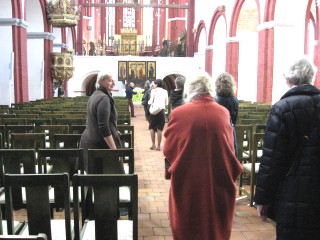 |
|
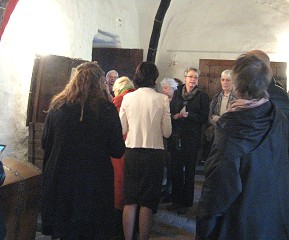 |
| home | Last revised October 11, 2015 |